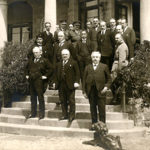Published March 15, 2001
Family Policy Vol. 14, No. 2, March-April 2001, pp. 15-18.
Few states are expected to follow the lead of Vermont and enact “civil unions” or domestic partnership legislation. Yet if faced with demands to be like the Green Mountain State, lawmakers in other states would be wise to commission economic impact statements to assess the potential fiscal and economic fallout. Judging from the economic legacy of the Supreme Court decision a generation ago that forced every state in the union to liberalize their respective abortion laws, changes in state social policy and especially marriage law are never economically neutral. In fact, reducing the legal status of marriage to anything other than a union between one man and one woman will actually work against the economic vitality of a state.
That a change in social policy exerts far different consequences from what is often expected or predicted is demonstrated in the case of legalized abortion.(1) As George A. Akerlof and Janet L. Yellen of the Brookings Institution write: “Although many observers expected liberalized abortion and contraception to lead to fewer out-of-wedlock births, in fact the opposite happened [particularly] because of the erosion of the custom of ‘shotgun marriages.'”(2) By making the birth of a child the physical choice of the mother, Akerlof and Yellen point out, the legalization of abortion had the unanticipated result of making acceptance of the responsibilities of marriage and child support also a choice of the father, not the ordinary consequence. While the number and rate of abortions soared and the live birth rate declined immediately, the number and proportion of out-of-wedlock pregnancies and births also rose sharply over time.
How Abortion Changed Family Economics
The loosening of divorce laws at the time abortion was legalized seems to make sorting cause from effect difficult. But the role of legal abortion becomes clear when the rise in the abortion rate is compared with the net marriage rate (the marriage rate minus the divorce rate). The net marriage rate fell by 35 percent between 1968 and 1976, exactly the period of the most rapid increase of the abortion rate and decline of the live birth rate. Since 1976, the net marriage rate has fallen an additional 4 percent compared with the rate in 1968.(3)
These changes in marriage exerted profoundly negative economic consequences in terms of the level and buying power of average American household income. Consider, for example, what happens when a man and a woman divorce or fail to marry in the first place. Living together, their income is combined into one household; after divorce, or as separate individuals, their income is split between two households. The difference is more than merely mathematical, however, because two adults can live in one household much more cheaply than in two separate households. The official poverty level in 2000 for an adult living alone was $8,959; for a household of two adults it was $11,531, far less than the poverty level for two separate households, which would be $17,918.(4) Thus, with the same income in both cases, the combined standard of living declines by at least $6,387 after a couple divorces or fails to marry, even if they have no children. The difference in the cost of living is even larger for those above the poverty line, as this estimate represents only the minimum change.
The decline in living standards hurts the woman more than the man, as earnings for men are nearly twice as high as for women. For those born in 1955, the average married man can expect lifetime earnings to average about $31,491 in 2000 dollars; the average married woman, $15,544. Together, the couple can expect a combined average lifetime income of $47,035.(5) For two unmarried people with the same age and education, average expected lifetime earnings are $28,122 for the man and $16,676 for the woman, a total of $44,798. The differences are due to these facts: Married men work more hours than unmarried or divorced men; unmarried or divorced women work more hours in the labor market than married women. Thus, as the result of failing to marry or getting a divorce, the average annual lifetime standard of living of such a couple would decline by at least $8,624, or 18 percent, due to lower earnings and a higher cost of living.
Since the legalization of abortion was associated with a 39 percent decline in the net marriage rate, up to 39 percent of U.S. house-holds would be subject to a drop of at least 18 percent in their standard of living over time. Other things being equal, this means that behavioral changes brought about by abortion helped lower the average American household’s standard of living about 6 percent.
The same analysis can be applied to the case of homosexual “unions” or domestic partner-ships. Supporters of domestic partnership legislation often claim that making domestic partnerships equivalent to marriage will not affect anyone’s self-identified sexual orientation or behavior, even as they claim such legislation will affect whether or where they marry. This is a rather extreme claim, because it assumes that homosexual behavior is entirely genetic and not at all cultural. As research has identified several environmental factors that contribute to homosexual behavior, a presumption that a major change in the law that upholds domestic partnership as equivalent to marriage would likewise not affect the prevailing norms of behavior is naïve at best.
What Sexual Behaviors Might Change
Calculating how those norms of behavior will change requires a look at the sexual behavior of Americans. A 1998 study by the Institute for Gay and Lesbian Strategic Studies noted that estimates of the share of the American population that considers itself homosexual range from 1 to 10 percent, but that “the most recent academic study survey in 1992 finds that 2.8 percent of men and 1.4 percent of women identifies themselves as homosexual or lesbian.” The 1998 study further noted, “A quarter of the gay or bisexual individuals in the 1992 study were cohabiting with a same-sex partner (0.72 percent of men and 0.39 percent of women).”(6) The study took this cohabiting figure as a benchmark, but based its range of estimates on values ranging from 0.18 percent to 10 percent of the population.
Although the direct interest of the Institute for Gay and Lesbian Strategic Studies in securing domestic partnership legislation limits the study’s objectivity, the report nevertheless reveals facts upon which opponents can agree. First, male homosexuality is about twice as prevalent as female homosexuality. Second, about three-quarters of all self-identified homosexuals do not live with a partner. Third, homosexual couples do not behave in economic terms like heterosexual couples. The Institute study cites U.S. Census data showing that, in 71 percent of male same-sex couples and 59 percent of female same-sex couples (as com-pared to only 41 percent of heterosexual couples), both persons work more than thirty hours a week in the labor market. To paraphrase Gary Becker, the 1992 Nobel-Prize winner in economics, homosexual couples do not specialize their roles nearly as much as do heterosexual couples.(7)
If a change in the law will influence self-identification and sexual behavior, the 10 percent upper limit suggested by advocates of domestic partnership or gay marriage implies that the 2.1 percent share of the current population that self-identifies as homosexual (average of the 2.8 percent of men and 1.4 percent of women who claim to be homosexual) might rise over time by another 7.9 percentage points. Since male homosexuality is about twice as prevalent as female homosexuality, the 10 percent upper limit would really mean that 13.3 percent of men and 6.7 percent of women would, over time, identify themselves as homosexuals. Moreover, the finding that only one-quarter of homosexuals live with a same-sex partner, while three-quarters do not, means that the change in the law might alter sexual behavior but not lead to a dramatic increase in domestic partnerships. Finally, in addition to men and women who changed their self-identification or behavior on homosexuality, 6.7 percent of women would remain heterosexual but be unable to find men to marry.
The Swing Group
To better understand the dynamics, suppose that a group of four pairs of men and women in Vermont—who were likely to get married under the old law and custom—represent the 7.9 percent of the population whose behavior might change as the result of a change in marriage law. After the change in behavior, those four pairs become three same-sex couples, two male couples and one female couple. The remaining two unpaired women will remain single, being unable to find a male marriage partner.
Every one of these eight individuals will change his or her labor market behavior from the average earnings of a married man or woman, to the average earnings of an unmarried man or woman. Average earnings of men will go down; average earnings of women will go up. As noted above, their lifetime earnings as a group will decline 4.8 percent. The effect on the average household cost of living will be slightly different from the earlier example, in which everyone was assumed to begin and remain heterosexual. Of the three-quarters of this group of four couples that now comes to identify itself as homosexuals, only one-quarter will be candidates for domestic partnership. This means that at most 18.75 percent (three-sixteenths) of the whole group will not experience a rise in the cost of living: Their standard of living will decline only by the 4.8 percent average drop in earnings. But the other 81.25 percent of the group whose behavior is affected by the change in law will see their living standard fall by at least 18.3 percent, because they have both lower earnings and a higher cost of living.
The arithmetic shows that the average standard of living for the whole group declines by 15.8 percent. Since this “swing group” makes up 7.9 percent of the total population, the standard of living of the whole working population will decline by at least 1.25 percent (15.8 percent times 7.9 percent). Since labor compensation makes up about 70 percent of the whole economy, this will effectively reduce the real buying power of gross state product by a minimum of about 0.87 percent. That may not sound like a lot, but it is. In 1998, Vermont’s gross state product was $16.257 billion.(8) Therefore, at 1998 income levels, the permanent decline in real income is about $142 million a year.
For the purpose of comparison, the Institute for Gay and Lesbian Strategic Studies predicted during the deliberations over “civil unions” last year that Vermont would temporarily gain tourist expenditures of $40 million a year for five years and $3.6 million a year in additional revenue from the room and services tax, based upon the state drawing homosexual couples from other states to cross the border to tie the knot.(9) The upper range of that estimate, corresponding to a homosexual population of 10 percent instead of 2.1 percent of the total, was almost five times that large. In that case the tradeoff would be a temporary gain of $200 million a year for five years, against a permanent loss of $142 million a year. Economists weigh such things in the same scale, by converting both numbers into “present value,” which means that future dollars are discounted into a lump sum at the current rate of interest, which is about 6.1 percent on the longest-term government debt. The present value of a $200 million a year gain for five years, discounted at 6.1 percent, is equal to a lump sum of $840 million to the citizens of Vermont. The present value of a perpetual $142 million a year loss, discounted at 6.1 percent, is $2.3 billion.
Granting every favorable assumption in the Institute study, then, the maximum possible benefit when considered in static terms would actually be a net loss of $1.488 billion when the dynamic behavioral changes are considered. Of course, that study assumed the legal enforcement of homosexual marriage, not domestic partnership. If the temporary tourism from other states did not materialize—because Vermont domestic partnership was not recognized as marriage in the home state—the people of Vermont would lose about $2.3 billion in 1998 dollars.
While the numbers regarding the impact on Vermont’s real economy are firmly based, the consequences for Vermont fiscal policy are less clear. According to the U.S. Census Bureau, the State of Vermont collected total taxes of $899 million in 1997, or 5.9 percent of its gross state” product.(10) If the economic impact were to occur entirely through a reduction in nominal income, this would suggest an annual loss of state tax revenue of $8 million a year, or a present-value loss of $131 million in 1997 dollars. But only about a quarter of the effect is due to a drop in nominal income; the rest is a decline in real income that increases poverty by raising the cost of living. As a first approximation, the total fiscal impact would be about the same, but the other three-quarters of the fiscal impact would come about through increased spending required to alleviate the increase in poverty.
(This article was adapted from testimony Mr. Mueller delivered to the Vermont House Ways and Means Committee in February 2000.)
NOTES
1. John D. Mueller, “The Socioeconomic Costs of Roe v. Wade: How America Would Be Stronger Had Abortion Remained Illegal,” Family Policy, March-April 2000, pp. 1-20.
2. George A. Akerlof and Janet L. Yellen, “An Analysis of Out-of-Wedlock Births in the United States,” Policy Brief No. 5, The Brookings Institution, 1996. The original article appeared in the May 1996 issue of the Quarterly Journal of Economics.
3. Vital Statistics of the United States (Washington: U.S. National Center for Health Statistics, 2000).
4. U.S. Bureau of the Census.
5. These examples are derived from U.S. Census data described in John Mueller, “Winners and Losers from ‘Privatizing’ Social Security,” National Committee to Preserve Social Security and Medicare, March 1999.
6. M. V. Lee Badgett, “The Fiscal Impact on Vermont of Allowing Same-Sex Couples to Marry,” Institute for Gay and Lesbian Strategic Studies, 1998.
7. Gary S. Becker, A Treatise on the Family: Enlarged Edition (Cambridge: Harvard University Press, 1994), p. 330.
8. Survey of Current Business, U.S. Department of Commerce, January 2000, p. D-68.
9. Badgett, “The Fiscal Impact on Vermont of Allowing Same-Sex Couples to Marry.”
10. Statistical Abstract of the United States: 1999, 119th edition, (Washington: U.S. Bureau of the Census, 1999) p. 326.








